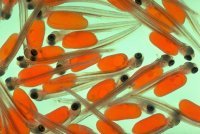FOOD SOURCES
FRESH WATER
Newly hatched salmon feed on large food sacs on their bellies.
 When salmon first hatch, they are called alevin. Alevin have large yolk sacs attached to their bellies which is their food until it is used up. Once the yolk sac has been digested, the alevin are usually swimming above their gravel birthplace and are hunting for other food. The alevin are then known as fry.
When salmon first hatch, they are called alevin. Alevin have large yolk sacs attached to their bellies which is their food until it is used up. Once the yolk sac has been digested, the alevin are usually swimming above their gravel birthplace and are hunting for other food. The alevin are then known as fry.
As the salmon grow, they eat insects and their larvae.
 Insects and their larvae are the principal food sources for young salmon fry. The majority of a growing salmon's diet consists of a variety of aquatic insects. Mayfly, caddisfly, and stonefly nymphs are common food sources for the growing salmon fry. Although most of these insects spend their larval or pupal stages under water, they will in fact spend their adulthood flying in the air.
Insects and their larvae are the principal food sources for young salmon fry. The majority of a growing salmon's diet consists of a variety of aquatic insects. Mayfly, caddisfly, and stonefly nymphs are common food sources for the growing salmon fry. Although most of these insects spend their larval or pupal stages under water, they will in fact spend their adulthood flying in the air.
Another food source for salmon are the insects that live on the surrounding vegetation. While feeding on overhanging plants, these insects will often fall into the stream providing added food to hungry fish. These insects and larvae (often dead) are a good supplement to the aquatic insect diet for a growing salmon in freshwater. As salmon reach the yearling age, fry from other species or even their own species can also be a great food source.
IN SALT WATER
In the ocean, salmon feed on bigger food like shrimp and smelts.
Once the growing salmon migrates to the ocean, its appetite craves larger prey. Sea creatures such as shrimp, crabs, surf smelts, herring, amphipods, and their larvae, as well as other smaller salmon fry make up the diets of a fast-growing coho salmon in the ocean.
AS ADULT SPAWNING SALMON
When salmon return home to lay eggs, they eat very little.
Once the adult salmon returns to fresh water to lay and fertilize eggs, their feeding virtually stops. If an insect, salmon fry, or other food is very convenient, they may try to catch it. But mostly, they stop feeding so their energy can be used to reproduce.
Top of page.

